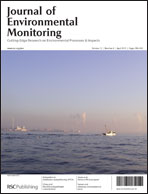PAHs and n-alkanes in Mediterranean coastal marine sediments: aquaculture as a significant point source
Abstract
The occurrence of polycyclic aromatic and aliphatic hydrocarbons in fish feed, sediment trap material and marine sediments was examined at two fish farms in the eastern Mediterranean. The average (min–max) concentrations of polycyclic aromatic hydrocarbons (PAHs) in fish feed and particulate effluents were 316 (287–351) ng g−1


 Please wait while we load your content...
Please wait while we load your content...